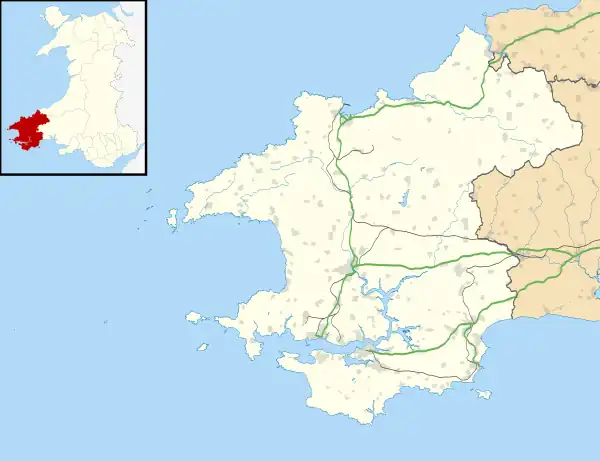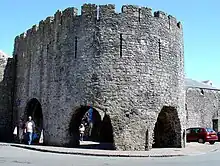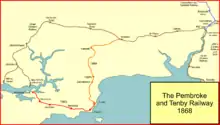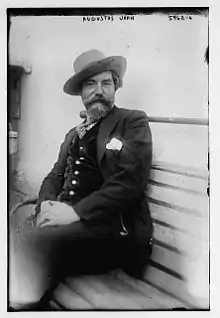Tenby
Tenby (Welsh: Dinbych-y-pysgod, lit. 'fortlet of the fish') is a seaside town and community in the county of Pembrokeshire, Wales. It lies within Carmarthen Bay.
Tenby
| |
|---|---|
 The harbour and old town | |
 Tenby Location within Pembrokeshire | |
| Population | 4,696 (2011 census)[1] |
| OS grid reference | SN129007 |
| Principal area | |
| Preserved county | |
| Country | Wales |
| Sovereign state | United Kingdom |
| Post town | TENBY |
| Postcode district | SA70 |
| Dialling code | 01834 |
| Police | Dyfed-Powys |
| Fire | Mid and West Wales |
| Ambulance | Welsh |
| UK Parliament | |
| Senedd Cymru – Welsh Parliament | |
| Website | www.aroundtenby.co.uk |
Notable features include 3 miles (4.8 km) of sandy beaches and the Pembrokeshire Coast Path, the 13th-century medieval town walls, including the Five Arches barbican gatehouse, Tenby Museum and Art Gallery, the 15th-century St. Mary's Church, and the National Trust's Tudor Merchant's House.
Boats sail from Tenby's harbour to the offshore monastic Caldey Island. St Catherine's Island is tidal and has a 19th-century Palmerston Fort.
The town has an operating railway station. The A478 road from Cardigan, Ceredigion, connects Tenby with the M4 via the A477, the A40 and the A48 in approximately 40 miles (64 km).
History





With its strategic position on the far west coast of Britain, and a natural sheltered harbour from both the Atlantic Ocean and the Irish Sea, Tenby was a natural settlement point, probably a hill fort with the mercantile nature of the settlement possibly developing under Hiberno-Norse influence. The earliest reference to a settlement at Tenby is in Etmic Dinbych, a poem probably from the 9th century, preserved in the 14th-century Book of Taliesin.[2]
Tenby was taken by the Normans, when they invaded West Wales in the early 12th century. The town's first stone-wall fortification was on Castle Hill. Tenby's mercantile trade grew as it developed as a major seaport in Norman controlled Little England beyond Wales. However, the need for additional defences became paramount after the settlement and castle were successfully attacked and sacked by Welsh forces of Maredudd ap Gruffydd and Rhys ap Gruffydd in 1153. Sacking of the town was repeated in 1187 and again by Llywelyn ap Gruffudd in 1260.[3] After the final attack, William de Valence, 1st Earl of Pembroke ordered the construction of the Tenby town walls in the late 13th century. The stone curtain wall, towers and gates enclosed a large part of the settlement—now known as the "old town". With the construction of the town walls, Tenby Castle was made obsolete and had been abandoned by the end of the 14th century.[4]
In 1457, Jasper Tudor, the uncle of Henry Tudor, agreed to share with the town's merchants the costs of refurbishing and improving Tenby's defences because of its economic importance to this part of Wales. Work included heightening the wall to include a second tier of higher arrow slits behind a new parapet walk. Additional turret towers were added to the ends of the walls where they abutted the cliff edges, and the dry ditch outside walls was widened to 30 feet (9.1 m).
Consequently, in the Late Middle Ages, Tenby was awarded royal grants to finance the maintenance and improvement of its defences and the enclosure of its harbour. Traders sailed along the coast to Bristol and Ireland and further afield to France, Spain and Portugal. Exports included wool, skins, canvas, coal, iron and oil; while in 1566 Portuguese seamen landed the first oranges in Wales.[4] It was during this period that the town was so busy and important, it was considered to be a national port. During the Wars of the Roses Henry Tudor, the future King Henry VII of England, sheltered at Tenby before sailing into exile in 1471.
In the mid-16th century, the large D-shaped tower formerly known as the "Five Arches tavern" was built following fears of a second Spanish Armada.
Two key events caused the town to undergo rapid and permanent decline in importance. First, Tenby declared for Parliament in the English Civil War. After resisting two attempts by the Royalists forces of Charles Gerard, 1st Earl of Macclesfield, it was finally taken in 1648. Ten weeks later the shattered town was surrendered to Colonel Thomas Horton, who welcomed Oliver Cromwell shortly afterwards.[3][4] Second, a plague outbreak killed half of the town's remaining population in 1650.
With limited infrastructure, resources and people, the town's economy fell into decline. Most of the merchant and business class left, resulting in the town's decay and ruin. By the end of the 18th century, John Wesley noted during his visit how: "Two-thirds of the old town is in ruins or has entirely vanished. Pigs roam among the abandoned houses and Tenby presents a dismal spectacle."[5]
Another war led to a resurgence in Tenby's fortunes. Since 1798, the French General Napoleon Bonaparte had begun conquering Europe restricting the rich British upper classes from making their Grand Tours to continental spa towns. In 1802 local resident, merchant banker and politician, Sir William Paxton, bought his first property in the old town. From this point onwards he invested heavily in the area with the full approval of the town council.
With the growth in saltwater sea-bathing for health purposes, Paxton engaged engineer James Grier and architect Samuel Pepys Cockerell (the same team who had built his home at Middleton Hall) to create a "fashionable bathing establishment suitable for the highest society." His sea-bathing baths came into operation in July 1806 and, after acquiring the Globe Inn, transformed it into "a most lofty, elegant and convenient style" to lodge the more elegant visitors to his baths. Cottages were erected adjoining the baths with adjoining livery stables and coach house.
A road was built on arches overlooking the harbour at Paxton's full expense in 1814. He had a Private Act of Parliament passed that enabled fresh water to be piped through the town. Despite these accomplishments, his 1809 theatre was closed in 1818 due to lack of patronage.[5] The Market Hall was completed in 1829 and remodelled to serve as Tenby Town Hall in 1860.[6]
Paxton also took in "tour" developments in the area as required by rich Victorian tourists. This included the discovery of a chalybeate spring in his own park at Middleton Hall, and coaching inns from Swansea to Narberth. He built Paxton's Tower, in memorial to Lord Nelson whom he had met in 1802 when mayor of Carmarthen.[5] Paxton's efforts to revive the town succeeded and after the Battle of Trafalgar, the growth of Victorian Tenby was inevitable.
Through both the Georgian and Victorian eras Tenby was renowned as a health resort and centre for botanical and geological study.[7] With many features of the town being constructed to provide areas for healthy seaside walks, due to the walkways being built to accommodate Victorian nannies pushing prams, many of the beaches today still retain good disabled access. In 1856 writer Mary Ann Evans (pen-name George Eliot) accompanied George Henry Lewes to Tenby to gather materials for his work Seaside Studies published in 1858.

In 1852, the Shipwrecked Fishermen and Mariners' Royal Benevolent Society deployed a lifeboat to the town, taken over in 1854 by the Royal National Lifeboat Institution. In 1905 a slip-way equipped lifeboat station was built on Castle Hill. It was replaced by a modern station in 2008.
Tenby railway station and the Pembroke and Tenby Railway were opened as far as Pembroke on 30 July 1863. The extended line to Pembroke Dock opened on 8 August 1864. In 1866, the line was connected to Whitland railway station.[8] In 1867, work began on the construction of the Palmerston Fort on St Catherine's Island. The Army had control of the fort during 1887–1895.[9]
The old town castle walls have survived, as does the Victorian revival architecture in a pastel colour scheme. The economy is based on tourism, supported by a range of craft, art and other stores. As of April 2017, there are 372 listed buildings and other structures in and around Tenby.[10]
Governance
There are two tiers of local government covering Tenby, at community (town) and county level: Tenby Town Council and Pembrokeshire County Council. The town council is based at the De Valence Pavilion on Upper Frog Street.[11]
Tenby was an ancient borough, having been given a charter in 1290 by William de Valence, 1st Earl of Pembroke, and being formally incorporated as a borough by Elizabeth I in 1581.[12] The borough was reformed to become a municipal borough in 1836. From 1860 until 1947 the borough council was based at Tenby Town Hall on High Street.[6] In 1947 the council moved to Croft House on The Norton, later renaming it Guildhall.[13][14] Tenby Borough Council was abolished under the Local Government Act 1972, with the area becoming part of the new district of South Pembrokeshire within the county of Dyfed on 1 April 1974. A community was established to cover the area of the former borough, with its council taking the name Tenby Town Council.[15][16] The town council continued to be based at the guildhall until the mid-1980s when it moved to the De Valence Pavilion on Upper Frog Street.[17][18] The district of South Pembrokeshire was abolished in 1996, with the area becoming part of a re-established Pembrokeshire.[19]
Education
There are four schools in the Tenby schools area, consisting of three primary schools and one secondary school: Ysgol Hafan-y-Mor, Tenby Church in Wales Primary School, St. Teilo's RC School and Ysgol Greenhill Secondary.
Pupils from St. Teilo's School and Tenby Church in Wales School are automatically enrolled in the Greenhill School, but parents can enrol them into a different school. Ysgol Hafan y Môr is a Welsh language medium school. Most of the pupils go on to Ysgol y Preseli, a Welsh-medium secondary school in Crymych.
Previous schools in the area were Tenby V.C. Infants School which was an English medium school with a Welsh unit. Pupils from this school would automatically enrol in Tenby Junior School which has now been converted into Ysgol Hafan y Môr. Tenby V.C. Infant school was demolished in 2016 and turned into a field for the nearby Greenhill School.
Tourism

Attractions include the two sheltered, sandy beaches and the coastal boat trips to Caldey Island. St Catherine's Island is tidal and the site of St Catherine's Fort a 19th-century Palmerston Fort. In August 2016, the fort faced an "uncertain future" and was closed to the public.[20] Tenby has shops, pubs and restaurants to cater for visitors. The Sunday Times rated Tenby's Castle Beach the best beach in the UK in 2019.[21]
Transport


Tenby railway station serves the town on the Pembroke Dock branch of the West Wales Line operated by Transport for Wales Rail, who also manage the station. Trains run in each direction; westwards towards Pembroke and eastwards to Whitland, Carmarthen and Swansea. In peak season, trains run direct from Paddington to Tenby on Saturdays.
The nearest airport is Cardiff International.
Sport
Tenby United RFC, a rugby union club has existed since 1876. It is a member of the Welsh Rugby Union.
In 1970, the Tenby Sea Swimming Association started the Boxing Day Swim. It is Tenby's main Christmas attraction now, with approximately 600 swimmers, most in fancy dress, watched by thousands of onlookers. Each swimmer who enters for a charity receives a medal. The Osborne family has been associated with the event from the beginning and Chris Osborne, chairman of TSSA has seen it take place in every weather condition, from brilliant sunshine to freezing winds.[22]
Tenby hosts the Welsh Ironman Triathlon in September. There is also the Tenby Aces Cycling Club and the 18-hole Tenby Golf Course that provides links golf by the coast.
Notable people


- Robert Recorde (ca.1512 – 1558), an Anglo-Welsh physician and mathematician.[23]
- Sir William Paxton (1744−1824), a Scottish-born sailor, businessman and Welsh MP for Carmarthen; he developed Tenby into a seaside resort.[24]
- Charles Norris (1779–1858), an English topographical etcher and writer; moved to Tenby in 1810.[25]
- David Thomas (1813–1894), preacher and publisher of The Homilist, a magazine of liturgical thought.[26]
- George Edward Day (1815–1872), a Welsh physician.[27]
- Fanny Price-Gwynne (1819–1901), a Welsh novelist, artist, composer, poet and philanthropist; born in Tenby.[28]
- Thomas Purnell (1834–1889), author and London drama critic; born in Tenby.[29]
- Ernle Chatfield, 1st Baron Chatfield GCB, OM, KCMG, CVO, PC (1873–1967), a senior Royal Navy officer during WW1, educated at St Andrew's School, Tenby[30][31]
- Gwen John (1876–1939), a Welsh artist who worked in France
- Augustus John OM RA (1878–1961), a Welsh painter, draughtsman and etcher; born in Tenby.
- Tenby Davies (1884–1932), a Welsh athlete and half-mile world professional champion in 1909
- Nina Hamnett (1890–1956), a Welsh artist and writer, became known as the Queen of Bohemia; born in Tenby
- Cecil Woodham-Smith CBE (1896–1977), historian and biographer; she wrote about the Victorian era
- Kenneth Griffith (1921–2006), a Welsh actor and documentary filmmaker; born in Tenby
- Alison Bielski (1925–2014), poet and writer; wrote about Tenby
- Gwilym Prichard (1931–2015), a Welsh landscape painter, lived and died in Tenby
- Clive Merrison (born 1945), a British actor of film, TV, stage and radio; born in Tenby
- Rosie Swale-Pope MBE (born 1946), a British author, adventurer and marathon runner; lives in Tenby
- Michael Bonacini (born 1960), a Welsh-Canadian chef, born and raised in Tenby[32]
- Grant Llewellyn (born 1960), a Welsh conductor and music director of the North Carolina Symphony
- Rhidian Brook (born 1964), a Welsh novelist, screenwriter and broadcaster; born in Tenby
- Kate Lamb (born 1988), actress, grew up in Tenby.[33]
Wally the Walrus

On 19 March 2021, an Arctic walrus was spotted on the rocks of Broad Haven South beach, after initially making the journey over from Ireland. During its time in Tenby, it was situated primarily on the new RNLI Lifeboat Tenby slipway. Wally was not spotted between 5 and 8 April 2021 and there were concerns that sightseers had driven him away,[34] but he was back regularly resting on the slipway later in the month, and on one occasion had to be moved to allow the slipway to be used.[35]
Some believed that the walrus made the journey from the Arctic on an ice floe.[36] The RSPCA believes this is the most southernly sighting of the species; occasionally they can be seen in Scotland.[37]
Despite spending most of his days resting and scavenging for food, he has been causing some mischief. It was reported that he capsized a dingy and damaged a fishing boat trying to board the vessels.[36]
Freedom of the Town
The following people and military units have received the Freedom of the Town of Tenby.
Individuals
- David Lloyd George[38]
- Augustus John: 30 October 1959.[39]
- Wilfred Harrison MBE: 1969.
- Mrs Sue Lane: 10 May 2023.
- Cllr Trevor Hallett: 10 May 2023.
Climate
Tenby experiences a maritime climate with cool summers, mild winters and often high winds. Due to its coastal southwest position, it is one of the sunnier locations in Wales.
| Climate data for Tenby (23m elevation) 1981–2010 | |||||||||||||
|---|---|---|---|---|---|---|---|---|---|---|---|---|---|
| Month | Jan | Feb | Mar | Apr | May | Jun | Jul | Aug | Sep | Oct | Nov | Dec | Year |
| Average high °C (°F) | 8.7 (47.7) |
8.4 (47.1) |
10.0 (50.0) |
12.2 (54.0) |
15.1 (59.2) |
17.7 (63.9) |
19.6 (67.3) |
19.5 (67.1) |
17.5 (63.5) |
14.5 (58.1) |
11.5 (52.7) |
9.3 (48.7) |
13.7 (56.7) |
| Average low °C (°F) | 3.2 (37.8) |
2.7 (36.9) |
4.0 (39.2) |
5.2 (41.4) |
7.7 (45.9) |
10.3 (50.5) |
12.3 (54.1) |
12.1 (53.8) |
10.6 (51.1) |
8.5 (47.3) |
5.5 (41.9) |
3.6 (38.5) |
7.2 (45.0) |
| Average rainfall mm (inches) | 113.5 (4.47) |
80.8 (3.18) |
86.7 (3.41) |
65.3 (2.57) |
62.7 (2.47) |
65.5 (2.58) |
68.8 (2.71) |
91.9 (3.62) |
87.5 (3.44) |
130.2 (5.13) |
134.9 (5.31) |
123.1 (4.85) |
1,111 (43.74) |
| Average rainy days (≥ 1.0 mm) | 16.0 | 11.9 | 13.4 | 10.6 | 9.7 | 9.2 | 9.5 | 10.7 | 11.1 | 15.5 | 16.5 | 15.3 | 149.4 |
| Mean monthly sunshine hours | 62.7 | 83.4 | 119.5 | 185.3 | 215.6 | 209.8 | 209.9 | 197.7 | 150.7 | 107.9 | 69.9 | 54.2 | 1,666.5 |
| Source: metoffice.gov.uk[44] | |||||||||||||
See also
References
- "2 Ward populations 2011". Retrieved 21 April 2015.
- Pryce, Huw, ed. (1998). Literacy in Medieval Celtic Societies. Cambridge University Press. p. 29. ISBN 9780521570398.
- "Tenby Castle". castlewales.com.
- "tenby". penmar-tenby.co.uk. Archived from the original on 2 April 2012. Retrieved 16 September 2011.
- "Sir William Paxton". kuiters.org. Retrieved 16 September 2011.
- Cadw. "The Old Town Hall and Market Hall (6169)". National Historic Assets of Wales. Retrieved 5 June 2022.
- "Victorian History Tenby". virtualtenby.co.uk.
- History of Pembrokeshire Railways Pembrokeshire Virtual Museum. Retrieved 3 March 2009
- "St Catherine's Island". Retrieved 13 May 2015.
- "Listed Buildings in Tenby, Pembrokeshire". British Listed Buildings. Retrieved 21 April 2017.
- "Contact us". Tenby Town Council. Retrieved 7 August 2022.
- "Tenby Borough Records". Joint Information Systems Committee (JISC). Retrieved 7 August 2022.
- "£12,000 Hotel as Civic Centre". Western Mail. Cardiff. 1 May 1947. p. 3. Retrieved 7 August 2022.
- Cadw. "Croft House (6195)". National Historic Assets of Wales. Retrieved 7 August 2022.
- "Local Government Act 1972", legislation.gov.uk, The National Archives, 1972 c. 70, retrieved 31 July 2022
- "The Districts in Wales (Names) Order 1973", legislation.gov.uk, The National Archives, SI 1973/1, retrieved 31 July 2022
- Telephone directory, 1982: Tenby Town Council, Guildhall
- "No. 50544". The London Gazette. 9 June 1986. p. 7670.
- "Local Government (Wales) Act 1994", legislation.gov.uk, The National Archives, 1994 c. 19, retrieved 7 August 2022
- Mosalski, Ruth (14 August 2016). "Tenby landmark St Catherine's Island will close this month – just a year after it reopened". Wales Online. Retrieved 17 January 2017.
- Bruce Sinclair (21 July 2019). "Tenby beach named best in UK by Sunday Times". Tivyside Advertiser. Retrieved 21 July 2019.
- "Tenby Boxing Day Swim". Retrieved 4 February 2019.
- . Encyclopædia Britannica. Vol. 22 (11th ed.). 1911. p. 966.
- "Sir William Paxton". kuiters.org.
- Thomas, Daniel Lleufer (1895). . Dictionary of National Biography. Vol. 41. pp. 116–117.
- Boase, George Clement (1898). . Dictionary of National Biography. Vol. 56. p. 177-178.
- Stephen, Leslie, ed. (1888). . Dictionary of National Biography. Vol. 14. London: Smith, Elder & Co.
- "A Portrait of Fanny Price Gwynne". Pembrokeshire Historical Society. 12 December 2016. Retrieved 25 July 2019.
- Carlyle, E. I. (1896). . Dictionary of National Biography. Vol. 47. p. 48.
- Heathcote, Tony (2002) The British Admirals of the Fleet 1734–1995 Pen & Sword Ltd page 40 ISBN 0-85052-835-6
- "Boer War Memorial St. Andrew's School - Tenby - TracesOfWar.com". tracesofwar.com.
- "Michael Bonacini". Bell Media Television. Retrieved 9 May 2018.
- "Tenby actress Kate's return to TV's Call the Midwife", Western Telegraph, 28 December 2015. Retrieved 2016-04-07.
- "Wally the walrus: Crowds 'may have driven' creature from Tenby". BBC News. 7 April 2021. Retrieved 10 April 2021.
- "Wally the walrus: Lifeboat crew use horn to budge animal". BBC. 30 April 2021. Retrieved 1 May 2021.
- "Wally the Walrus 'flipped dinghy and tried to board fishing boat'". BBC News. 30 March 2021. Retrieved 3 April 2021.
- Owen, Cathy (31 March 2021). "Walrus basks in the sunshine in Tenby". WalesOnline. Retrieved 3 April 2021.
- "The honour of the freedom award". BBC. 10 September 2008.
- "Augustus John Artist Receives Freedom Borough His Editorial Stock Photo – Stock Image | Shutterstock". Shutterstock Editorial.
- Davies, Ruth (25 April 2023). "Freedom of Town honour for ex Tenby mayors Sue Lane and Trevor Hallett". The Western Telegraph. Retrieved 20 August 2023.
- Davies, Ruth (12 May 2023). "Freedom of Tenby conferred on ex-mayors,Trevor Hallett and Sue Lane". The Western Telegraph. Retrieved 20 August 2023.
- Evans, Paul (26 April 2023). "Freedom of the town for two Tenby Council stalwarts". The Tenby Observer. Retrieved 20 August 2023.
- Evans, Paul (11 May 2023). "Remarkable Tenby ambassadors given 'Freedom of the Town'". The Tenby Observer. Retrieved 20 August 2023.
- "Climate Normals 1981–2010". Met Office. Retrieved 24 February 2021.
.jpg.webp)
